STAINLESS STEEL BALL VALVES
General Information
Operation
These are manual ball valves used to shut-off flow. Ball valves provide a quick, quarter turn on-off operation. The direction of the lever handle indicates the ‘open’ position. The valves have a positive stop, cast into the valve body.
Stainless Steel Ball Valve Applications
Widely used across general industry, including Water, Oil, Gas, Chemical Industries and in Process Engineering. Being Stainless Steel, they are also commonly used wherever sanitary measures are required such as in the Dairy, Wine and Pharmaceutical Industries.
The Different Ball Valve Designs
Ball Valves come in different designs, either as 1 Piece, 2 Piece or 3 Piece configurations:
- In the single piece design valve, the body is cast/forged as one piece. The insertion of the ball will be through the end of the body. This design restricts the valve to a reduced bore.
- The 2-piece design provides for a full-bore option. The body is constructed in two pieces and the ball is held in position by body stud. The two piece body construction allows the valve to be manufactured with a larger ball making this a full bore valve. Note: there can be full or regular port design possibilities with this construction.
- In the case of three-piece construction, the body has two end pieces and one centre piece. The center part of the valve containing the ball, stem & seats to be easily removed from the pipeline. This construction permits in line servicing and cleaning without disturbing the existing pipe work. This ball valve can be taken apart the quickly and easily. A well-designed valve will not leak.
General Characteristics
1 Piece Ball Valve
- These are the best priced ball valves since the valve body is made from a single piece.
- The benefit of the single piece construction is there are no joints for leaking to occur.
- They are durable and reliable.
- No tooling required for installation.
- The downside to the one-piece design is that this makes the ball valve a standard port valve (reduced port)
2 Piece Ball Valve
- Also referred to as a two-way ball valve since it allows straight through flow from two directions.
- The 2-piece valve is a full port valve - the ID of the valve matches the pipe ID for the same nominal size.
- These are the most widely used in all industries due to their low cost, ease of use and durability.
- No tooling required.
3 Piece Ball Valve
- The distinctive feature of this valve is that it can be easily taken apart for cleaning.
- Widely used in the food and beverage industry and other applications where cleaning is required.
Seats and Seals
All are PTFE. PTFE is FDA Food Grade Compliant. Has an upper service temperature of 260°C.
Full Port
Full port/ bore means the hole in the ball will match the pipeline size. This results in lower friction loss.
Sizing
The pipe size determines the size of the ball valve required. A 2” (50mm) pipe will take a 2” (50mm) ball valve.
Certification
Stainless Steel Camlocks can be supplied with a 3.1 Material Certificate. Please notify us at the point of order. See sample certificate below
3 Way Ball Valves
A three-way ball valve shuts off flow in one pipe while opening flow to another pipe. They are used to either mix media from different pipes or divert flow from one pipe into another. 3 ports are connected to piping. They are available in L and T Port configurations:
L-Port – Generally used for diverter service – flow is directed between the center port and either of the 2 side ports.
- Application example: When emptying source tanks. Once one tank is empty the fluid can be drawn from the next tank.
- Note: A corner needs to be turned in both valve positions so there will be some pressure loss. If you want maximun flow in one direction a T-port valve might offer a solution.
T-Port - Commonly used for directing flow in two directions. These can also direct flow between the centre and one of two side ports per the L-Port configuration above. The difference is that they have a third position that connects the centre port to both side ports at the same time. You can also have straight through flow in one position.
- Application example: Drawing rainwater from two tanks, with the option of isolating one tank if it became contaminated. you might want to have straught throught flow when feeding water spray heads and use the divert port to drain the excess water.

Technical Specifications
Technical Specifications
One Piece SS Ball Valve
Features
- Blow-out Proof Stem
- Locking Device with Handle – can be removed
- Investment Casting (link here to information on casting)
General Specifications
Suitable Mediums: Water, Oil and Gas (WOG)
Seats and Seals: PTFE (Teflon)
Threads: Female BSPP (British Standard Pipe Thread - Parallel)
Port: Reduced Bore Ball Valve (ID is one size smaller than pipe ID)
Pressure Rating: 1000 PSI making them suitable for most applications.
Performance Specifications
| Pressure Rating: | 1000 PSI (69 bar) |
|---|---|
| Temperature: | -25°C to 150°C (-13°F to 302°F) |
| Shell (Body) Test: | 1392 PSI (96 bar) |
| Seat Test: | 87 PSI (6 bar) |
Materials
Valve Body: Stainless Steel 316 (CF8M)
Seats & Seals: Teflon (PTFE)
Compatibility: Suitable for use with any substances compatible with Stainless Steel and Teflon (PTFE)
Non-wetted parts: Stainless Steel 304 (parts that don’t interact with the material being transported)
General Dimensions


Pressure Chart

Design Data
Casting: Investment Casting AD2000-WO
Dimension standards: DIN3202/4-M3, din2999/259, ISO228-1,ISO7-1, ASME B1.20.1,BS21
CE Approval: DN32~DN100
Inspection & Testing: En12266-1,API 598
Shell test pressure :95 bar for DN6~DN50; 60bar for DN65~DN100
Shell Test Pressure: 95 Bar for DN6-DN50; 60 bar for DN65-DN00
Seal Pressure Test: 70 bar for DN6-~DN50; 44bar for DN65~DN100
Low Pressure Test : 6~8 bar
Pressure at max. Temperature:44.5 bar for 1.4308 and pn63,50.2bar for 144.8 adn PN63; 28.2 bar for 1.4308 and PN40,31.8 bar for 1.4408 and PN40
Pressure at min. Temperature: 59.7 bar for 1.4308 and PN63, 61.2 BAR FOR 1.4408 and PN63; 37.9 bar for1.4308 and PN40,38.8 bar p>for 1.4408 and PN40
Corrosive Allowance : 2mm
Design & Manufacture : According to EN12516-1/-2,PED97/23/EC (CE0036)
2 Piece Ball Valve
Features
- Blow-out Proof Stem
- Locking Device with Handle
- Investment Casting (link here to information on casting)
- All 2 Piece and 3 Piece Ball Valves are Full Port
General Specifications
Suitable Mediums: Water, Oil and Gas (WOG)
Seats and Seals: PTFE (Teflon)
Threads: Female BSPP British Standard Pipe Thread - Parallel)
Port: Full Port/ Full Bore (Internal Diameter remains same as the pipe ID)
Handle: Blow-Out Proof Design
Handle Locking Mechanism: Handle equipped with locking device (removable)
Pressure Rating: 1000 PSI making them suitable for most applications.
Performance Specifications
| Pressure Rating: | 1000 PSI (69 bar) |
|---|---|
| Temperature: | -25°C to 150°C (-13°F to 302°F) |
| Pressure Rating: | 1392 PSI (96 bar) |
| Pressure Rating: | 87 PSI (6 bar) |
Materials
Valve Body: Stainless Steel 316 (CF8M)
Seats & Seals: Teflon (PTFE)
Compatibility: Suitable for use with any substances compatible with Stainless Steel and Teflon (PTFE)
Non-wetted parts: Stainless Steel 304 (parts that don’t interact with the material being transported)
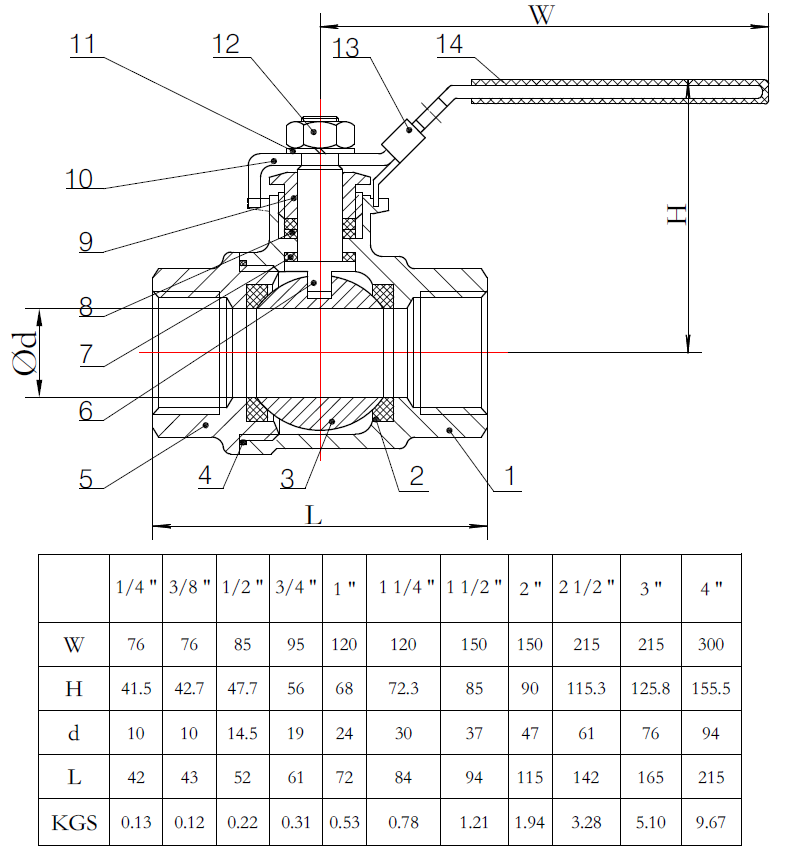
3 Piece Ball Valve
Features
General Dimensions
- This valve body comprises 3 segments; two end-sections and a removable central portion. 4 bolts slide in from one end-section to the other and are fastened with nuts.
- The two end-sections are threaded (both female BSP Parallel) with a removable central portion which holds the ball valve.
- The central portion can be removed for cleaning purposes. The two end-sections remain in situ. This facilitates easy access without having to unscrew the ball valve in its entirety.
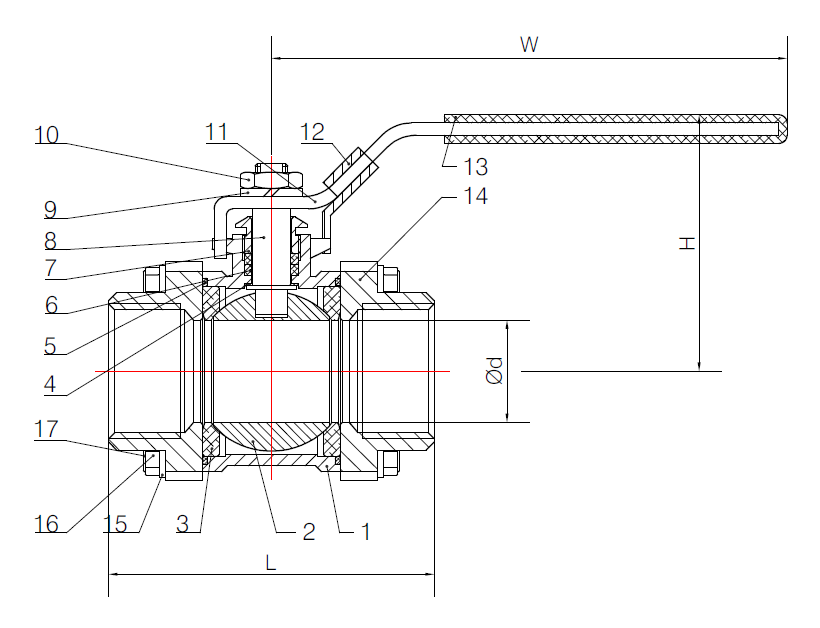
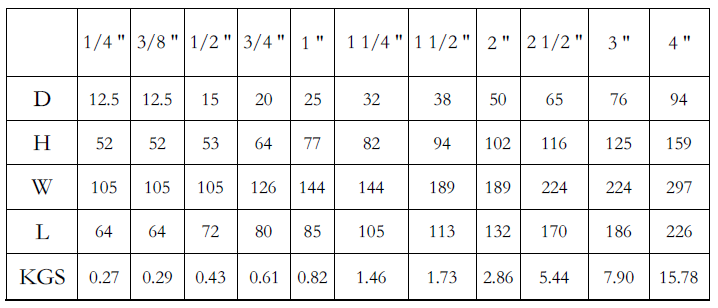
Pressure Chart
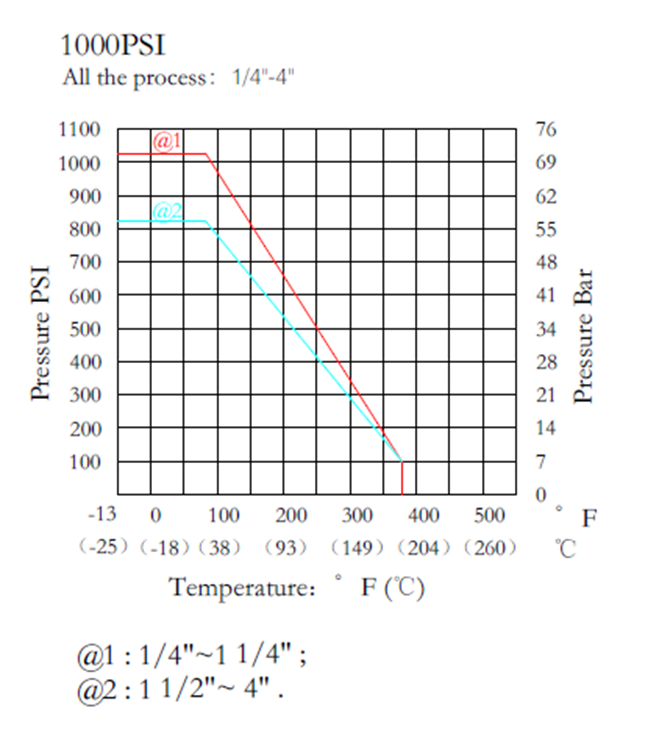
Design Data
Casting Standards: AD2000-WO
Design & Manufacture Standards: EN12516-1/-2, PED97/23/EC (CE0036)
Dimension Standards: DIN3202/4-M3, DIN2999/259, ISO228-1, ISO7-1, ASME B1.20.1, BS21
Valve Inspection & Testing According To: En12266-1, API 598
- Shell test pressure: 95 bar for DN6~DN50;60bar for DN65~DN100
- Seal Pressure Test: 70 bar for DN6-~DN50; 44bar for DN65~DN100
- Low Pressure Test: 6~8 bar
Suitable Mediums: Water, Oil and Gas (WOG)
Temperature Range: -14°F to 248°F (-10℃ ~ 120℃)
Pressure at max. Temperature: 44.5 bar for 1.4308 and pn63,50.2bar for 144.8 adn PN63; 28.2 bar for 1.4308 and PN40,31.8 bar for 1.4408 and PN40
Pressure at min. Temperature: 59.7 bar for 1.4308 and PN63, 61.2 BAR FOR 1.4408 and PN63; 37.9 bar for1.4308 and PN40,38.8 bar for 1.4408 and PN40
Corrosive Allowance: 2mm
CE Approval for: DN32~DN100.
Three Way Ball Valve
Features
- 3 Way Ball Valves are designated either L-Port or T-Port.
- The port designation is derived from the flow pattern produced.
- Both shapes provide options for diverting flow from or to different sources.
- The L-Port is used as a diverter valve, directing flow from one inlet to a choice between two outlets.
- In the case of a T-Port Valve, fluid can be directed to more than one location simultaneously.
Materials
Valve Body: Stainless Steel 316 or SS304
Seats & Seals: Teflon, also known as PTFE
Compatibility: Suitable for use with any substances compatible with Stainless Steel and Teflon (PTFE)
Non-wetted parts: Stainless Steel 304
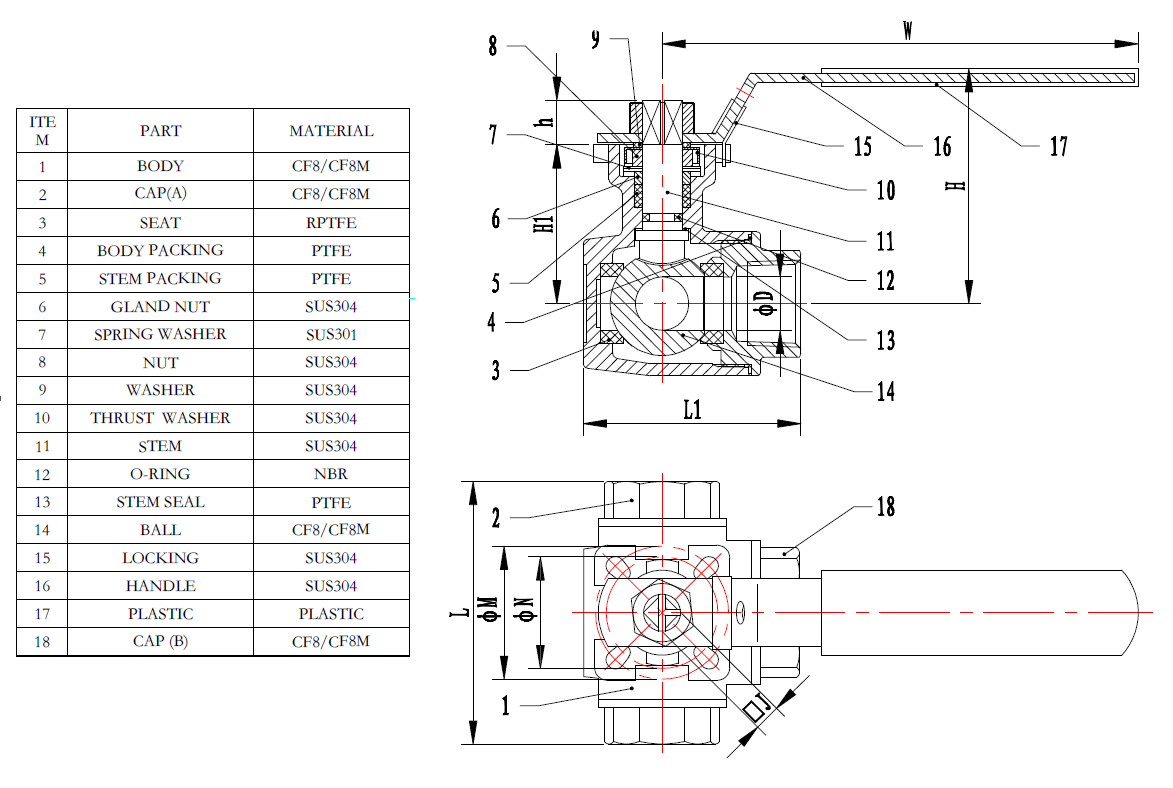
General Dimensions
- The body is manufactured as a single piece with three caps attached to each port end.
- This outlet configuration setup means that a 3 way ball valve cannot accept a ball as large as the 2 Piece & 3 Piece can.
- The ID is thus smaller than full port yet not as reduced as for the standard port or reduced port ball valves.
- ID of the 3 way ball valve is wider than that of the one piece ball valve of equivalent size.
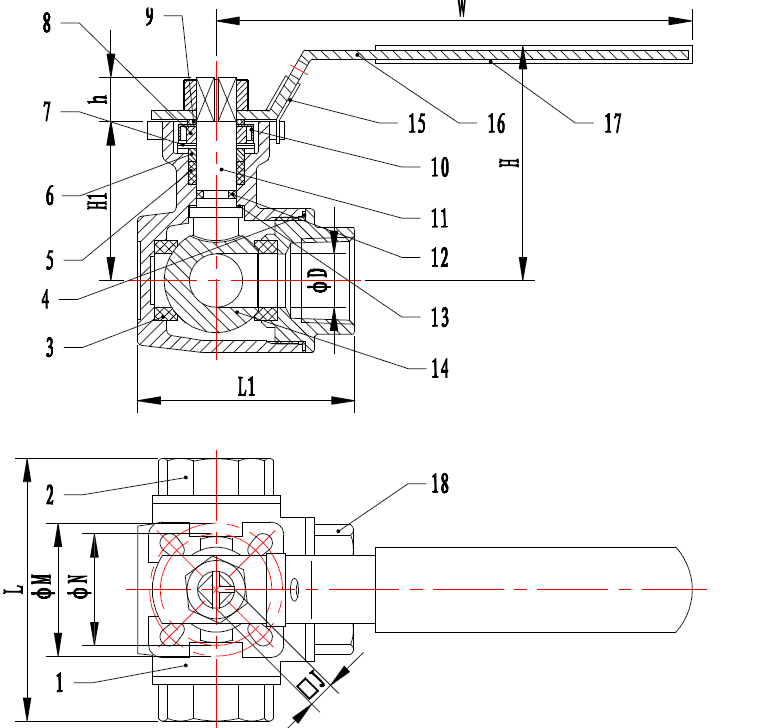
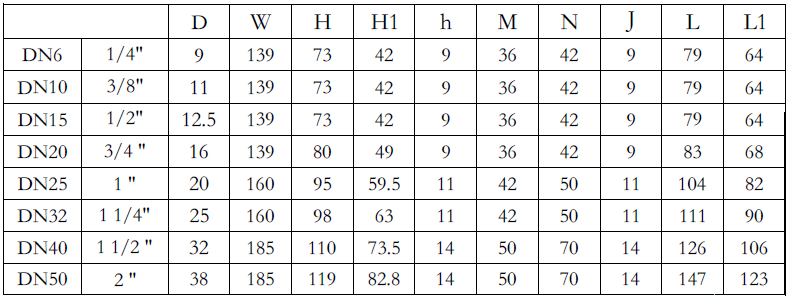
Pressure Chart
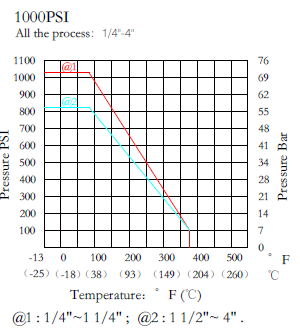
Certificate Example
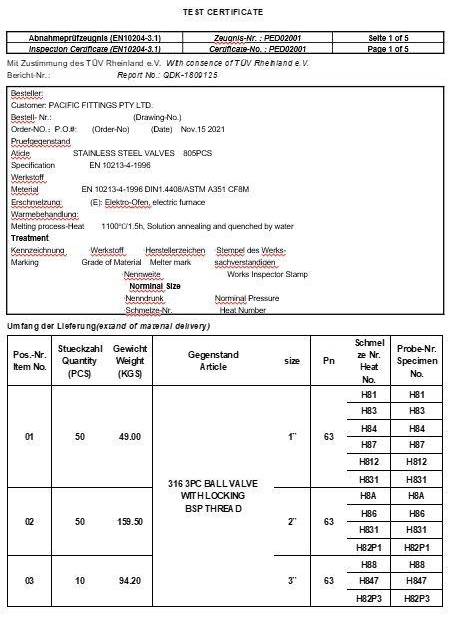
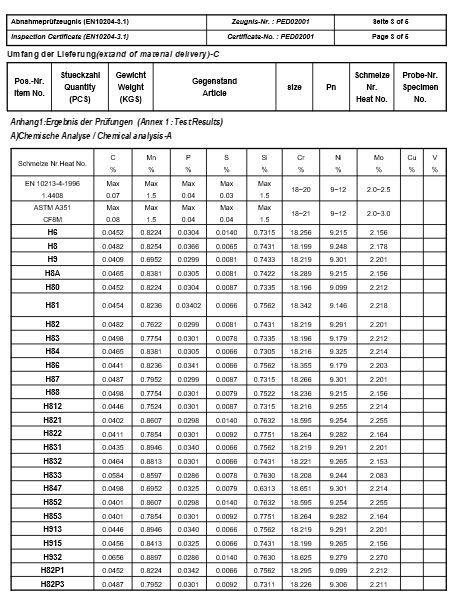
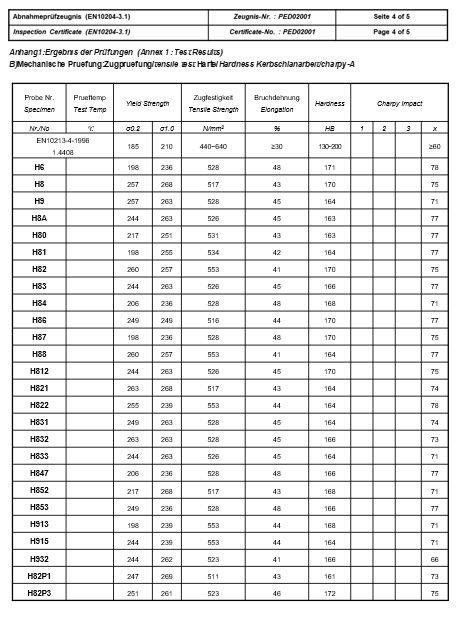
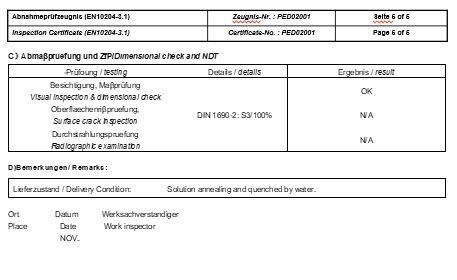
Common Questions
What does full port mean?
Full port/ bore means the hole in the ball will match the pipeline size. This results in lower friction loss.
Is there a difference in specification for a ‘compact’ vs ‘heavy/ regular’ style ball valve?
The specs are identical. Only difference lies in body size and weight.
Stainless Steel 304 or 316 Ball Valve?
The cast versions of 304 and 316 stainless steel are known as CF8 and CF8M respectively.
The make-up of the two alloys have similar chromium and nickel contents, however, SS316 (CF8M) contains 2% to 3% molybdenum that CF8 does not have.
The molybdenum provides high corrosion resistance to chlorides.




